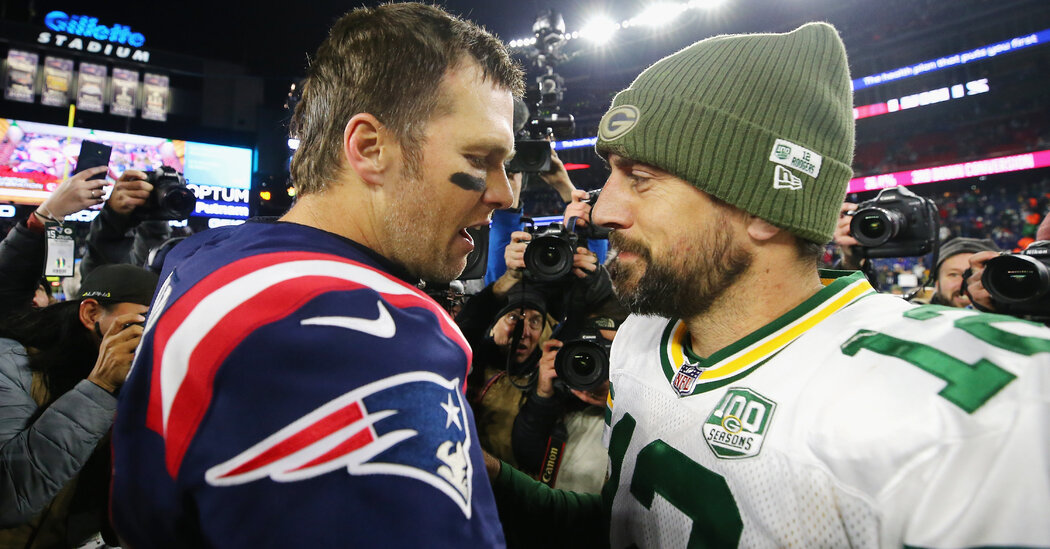
In these chaotic times, there is great comfort in the familiar, and the most familiar scene in the last four N.F.L. postseasons has been an A.F.C. championship game staged at Arrowhead Stadium, home of quarterback Patrick Mahomes and the Kansas City Chiefs.
His presence in this round feels inevitable. The absence of some others feels disorienting.
On Sunday, for the first time in 12 seasons, none of the triumvirate of Tom Brady, Aaron Rodgers and Ben Roethlisberger will be playing for a conference title, their Super Bowl hopes — and splendid careers, perhaps — expiring earlier these playoffs. At least one of those three quarterbacks has reached this stage in 18 of the past 20 seasons. And the lone outlier, before this one, came in the 2009 season, when, alas, we had to settle for Drew Brees, Brett Favre and Peyton Manning (along with Mark Sanchez).
Today, the older guys can still play: Rodgers, 38, very likely will win his second consecutive Most Valuable Player Award — and fourth overall — while Brady, who at 44 threw for a career-high 5,316 yards, should finish right behind him. But every season ushers the N.F.L. further away from one golden age of quarterbacking — of Brady and Rodgers, Brees and Manning — and toward another.
Not all eras end in a climactic moment, and the league’s current transition at quarterback has unfolded across several years. The pocket-passing prototype has yielded to a generation of mobile, accurate and creative stars unencumbered by convention or perception.
Kyler Murray of Arizona is 5-foot-10, and Justin Herbert of the Chargers is 6-foot-6, and there is room in the N.F.L. for both of them. Josh Allen of Buffalo can run between the tackles and throw clothesline passes. Lamar Jackson of Baltimore does the same. Joe Burrow, drafted No. 1 overall by league-worst Cincinnati in 2020, has shepherded the Bengals to the A.F.C. title game in 2021. Mahomes is an improvisational master.
With rule changes enabling scoring outbursts and statistical eruptions, these precocious quarterbacks, capable of gaining yards as proficiently on the ground as through the air, are being asked to bear a disproportionately high share in offensive production, according to a New York Times analysis of game and season statistics compiled by Pro Football Reference. It took until Manning’s fifth season, at 25, to account for 75 percent of his team’s yardage while he was in the game, and then another six before he did it again. Joe Montana broke 70 percent only once in a full season. At Dan Marino’s peak, he never surpassed 77.2.
Mahomes, meantime, has yet to account for less than 78.4 percent of Kansas City’s total when he is on the field. This past season Allen, at 25, factored into 81.3 percent of Buffalo’s offensive production — a dip from 2020 — while Jackson, 24, gained 84 percent of the Ravens’ yards while playing.
Aside from Murray, all of them play in the A.F.C., where the average age last season among the 16 starters at the position was 25.1. Only three — including Roethlisberger, 39, who announced his retirement Thursday — were at least 30. By contrast, the average age in the N.F.C. — inflated only somewhat by Rodgers and Brady — was 29.6.
Another crazy off-season of retirements, trades and signings in the offing will skew those numbers for next season, and teams who lack a great quarterback will again hatch plots to acquire one. Just look at the N.F.C. finalists, San Francisco and the Los Angeles Rams, who last year acquired successors — the 49ers drafted Trey Lance, and the Rams dealt for Matthew Stafford — for quarterbacks who had recently started in the Super Bowl. One of them, Jimmy Garoppolo of San Francisco, just might start in another.
But it is reassuring to know that with so many elite quarterbacks supported by front offices committed to optimizing rosters around them, there won’t be just one rivalry to dominate the next decade but many.
So even though this weekend might feel different — not good or bad, just different — take comfort in what is not a void but another phase of the natural progression of things. And besides, we’re probably going to see Brady versus Mahomes in the Super Bowl next year, anyway.
Jenny Vrentas contributed reporting.




